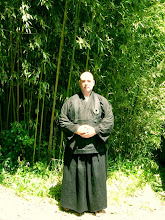
Vīrya (Pali: viriya) is a Sanskrit word which can be translated into English as "effort," "vigor*," "diligence," "zeal, and "energy." * Our English word ‘vigor’ actually stems from the same Indo-European root as does the Sanskrit ‘Virya’.

The practice of Virya is a practice in which we exert ourselves to the fullest in whatever task we undertake, giving our all to whatever it is that we are doing, no matter how seemingly mundane or relatively unimportant it may seem. The teachings of the 'Historical' (Shakyamuni) Buddha admonishes us not to approach whatever we do halfheartedly, but, rather, to put everything we have into it. Approach each and every undertaking with a full heart, dig down deep, and put your guts into it!!
From the Indo-European Rootword “w -ro-“, we derive not only the Sanskrit ‘Virya’ but also the following Englisha nd Latin words; ‘virago’, ‘virile’, ‘virtue’, ‘virtuosa’, and ‘virtuoso’.

In Buddhism, we use the term Vīrya in a number of instances, which may cause some confusion to new practitioners, or to those who have only a passing interest in Buddhism or Buddhist thought.
Vīrya is:
- One of the five controlling faculties (indriya).
- One of the five powers (bala).
- One of the six (or ten) paramitas.
- One of the seven factors of enlightenment (bodhyaṅga), and;
- Is identical with right effort of the Noble Eightfold Path (Pali: aṭṭhaṅgiko maggo; Skt.: aṣṭāṅga mārga).
- It stands for strenuous and sustained effort to overcome unskillful ways (akusala dhamma), such as indulging in unmoderated sensuality, ill will and harmfulness (see, e.g., ahimsa, nekkhamma).
- It stands for the right endeavour to attain dhyāna.
- Vīrya does not stand for physical strength.
- It signifies strength of character and the persistent effort for the well-being of others. In the absence of sustained efforts in practicing meditation, craving creeps in and the meditator comes under its influence. Right effort known as vīryabala is, thus, required to overcome unskillful mental factors and deviation from dhyāna.

* Zen is a ‘School’ or ‘Tradition’ of Buddhism, there are various schools or traditions which have their own focus and perhaps slightly different methods. Zen is 'a' way. There are many paths to the top of the mountain.

There are, more or less, three phases of Zen Training; Virya paramita: energy, effort, exertion, is called in Japanese ‘Shojin’. Thus then, the Fourth Paramita is actually the First Phase of the Three Phases of Zen, which are;
---THE THREE PHASES OF ZEN:
There are three phases or stages of training typically found common to Zen:
| The Japanese word for the First Phase, Shojin, translates as "ceaseless effort" or "constant effort." Said to be from the Sanskrit word "Virya" (in Pali: Viriya). |

Dharma Master Cheng Yen Fa-Shi, is one such Buddhist nun. In 1966, she founded the Tzu Chi Foundation after she witnessed the devastating poverty experienced by many Taiwanese people. She persuaded 30 housewives to form a group and to save 50 cents a day from their housekeeping money. This money was then used to help the poor. In one year, these 30 housewives helped 15 families. The foundation grew from there to its present size of more than 5 million supporters and 30,000 trained volunteers.
The organization also includes a Buddhist order of nuns, who further the work of the foundation. One thing I find fascinating about this order is that, unlike most other forms of Buddhism, they don't take any money from anyone for their own support.

Buddhist monks from Thailand's Sisaket province wanted a temple but had no money or much in the way of resources with which to obtain building supplies. Rather than lament what they were lacking, they took matters into their own hands and collected a million bottles to build the Wat Pa Maha Chedi Kaew temple.

Dying practice teaches us that time is passing, life is fleeting, and that living authentically and completely can only be achieved by being entirely present in the present moment. This means giving each and every moment everything that we have got to give, and holding nothing back at all. What might *you* do if you apply Virya Paramita to your daily life and practice?






No comments:
Post a Comment